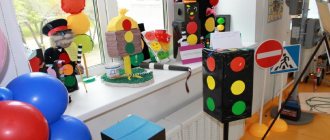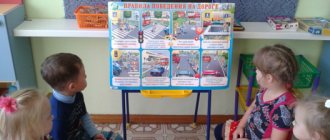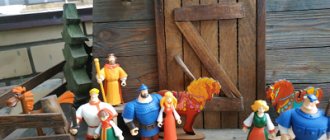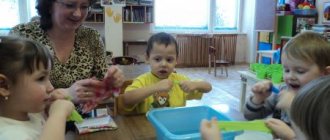Project on traffic rules in the preparatory group “Safe road for you and me”
Every year our city grows and becomes more beautiful. There are many wide, beautiful highways - streets, squares, avenues. The flow of traffic on the city streets is huge and endless - about two thousand cars pass every hour. About four thousand pedestrians pass through these same streets every hour. Among them, of course, are children. The child is interested in the street and everything that happens on it. And often, carried away by something unusual, he finds himself in life-threatening situations on the street. You need to know about them and be very careful. That is why, already at preschool age, it is necessary to teach children how to navigate the street.
Teaching children traffic rules requires teachers to have certain knowledge. We developed this project together with traffic police officers and parents.
Group project, informational and creative.
Project participants.
Children, parents, teachers, traffic police inspector.
Relevance of the topic.
The project is dedicated to a pressing problem - teaching preschool children the skills to behave safely on city streets. Children of this age do not have a protective reaction to traffic conditions. They do not yet know how to properly control their behavior and cannot correctly determine the distance to an approaching car. They have not yet developed the ability to anticipate possible danger in a rapidly changing traffic environment. Therefore, they are in danger on the roadway. You can avoid danger by teaching children the rules of the road. To develop children's skills for safe behavior on city streets.
Target.
To develop stable skills of safe behavior on the roads in children of senior preschool age and their parents.
Tasks.
- Create conditions for preschoolers to develop sustainable skills for safe behavior on the streets and roads.
- To form among parents a strong interest in the safety of children as road users, to involve adults in joint activities with children.
- Apply modern forms, methods of training and education aimed at preventing accidents with children on the streets of the city.
- To strengthen children's understanding of various types of transport.
- Introduce children to the concepts of street (road, roadway, sidewalk, markings, zebra crossing, traffic light, etc.).
- Use the capabilities of preschool educational institutions and material and technical potential for training and education of road users.
2 directions.
Joint activities with children.
Interaction with parents and traffic police inspector.
Project implementation period: 2017–2018.
Contents of the project work.
September.
Classes. Making a model of a large intersection (Mn. Priborostroitel).
To train children in orientation in traffic situations. Fix traffic rules and road signs.
Watching the film: “Be careful when you leave the house.”
Targeted walk along nearby streets (crossroads layout).
Monitoring the operation of vehicles and pedestrian behavior.
Remember the basic rules for crossing the street.
Reading a poem. A. Severny “Three wonderful colors”.
Games. Speech game. Playing out the situation “What will happen if you abolish traffic rules.” S/r game “At the Crossroads”.
Working with parents. Through joint efforts to create a developmental-subject environment (production of the DPS game.
October.
Classes. "Road signs".
To provide knowledge about the categories of signs: warning, prohibiting, informational, prescriptive. Learn to navigate using road signs.
Drawing. "Drawing traffic signs."
Target walk. Neighborhoods of our city. Introduce children to the microdistrict (Lesnoy). Clarify the rules of movement in microdistricts. Reinforce the concept of underground and overland passage.
Reading a poem. S. Mikhalkova “Walking carefully.”
Watching a video. "Remember these signs."
Games. D/game. Road signs. (lotto made with the participation of parents). S/r game “Forbidden - allowed.”
Meeting with the traffic police inspector. Conversation on the topic: child and the road.
Working with parents. Involve parents in the design of the exhibition: “Road rules are our best friends”
November.
Classes. "The emergence of a traffic light." Conversation about traffic rules. Tell children about the purpose of a traffic light, where and when the first traffic light appeared. To consolidate children's knowledge about the rules of crossing the street, to remember traffic signs.
Target walk. To the intersection with a traffic light (Mn. Priborostoroitel). To consolidate knowledge about traffic lights (red, yellow, green) and the rules for crossing the street (pedestrian crossing, green light).
Memorizing a poem. A. Severny "Traffic Light".
Games. D/i “Traffic Light” (consolidate children’s understanding of the purpose of a traffic light and its signals (joint work of teachers and parents). / P/game “The Fastest”.
Working with parents. Together (parents and children) they make attributes for the role-playing game (“Road and Children”) and design the corner “Road Traffic” in the group. Development of individual maps for children “The road to school and home.”
December.
Classes. Introduction to the work of a traffic controller. (to consolidate children’s knowledge about traffic light signals, to teach them to determine the appropriate actions of a traffic controller for a specific traffic light signal).
Target walk. “Getting to know the intersection” (introduce children to the types of intersections and traffic movement at the intersection, with warning light signals of cars when turning. Develop attention and observation (with the participation of parents)).
Reading a poem. S. Mikhalkov “Uncle Styopa the Policeman.”
Games. Di. “Guess by the description.” (learn to recognize by description and name road signs). S/r game “Drivers”, p/game “Drivers, pedestrians, cars”.
Working with parents. Publication of a newspaper for parents “Our Friendly Family”. (safe behavior of children on the streets of Stary Oskol). Parent conference: “Preventing childhood injuries is the task of the family and the public.”
January.
Classes. Workshop: “Solving problem situations.” (the teacher creates a problematic situation and asks what was done wrong).
Construction of "Road Test".
Watching a video. “We learn to cross the street correctly.”
Target walk. “We are driving through the city of Stary Oskol.” (continue to teach children to write stories from personal experience, remember the rules of safe behavior in city transport).
Reading stories. V. D. Sych “Skiing”, “Kolina’s Dream”.
Games. Di. “Our Rudnichny microdistrict.” (and a made model). P/game “Stop - go.” S/r game "Find pedestrians - violators."
Working with parents. (Together children and parents have fun “Our friend is a traffic light”).
February.
Classes. "My neighborhood." (with the help of photographs, consolidate children’s knowledge about the microdistricts in which they live (Mn. Rudnichny, Mn. Vesenny, Mn. Lebedinets).
Application (collective) “Our microroyon”.
Targeted walk to the Alexander Nevsky Temple. (introduce children to the overpass, talk about its necessity).
Reading stories. N. A. Izvekova “How funny little men learned the road alphabet.”
Games. Di. “Pick a road sign and tell us about it.” (learn to explain the meaning of signs, recognize and name them). P/game "Find a safe path."
Working with parents. Prepare a master class “Remember the rules of the road” with the Chernyaev family. Prepare information for parents: “What you need to pay attention to when walking with them along the city streets.” Questionnaire: “Me and my child on the city streets.”
March.
Classes. Game activity “It’s just a sign” (dramatization). To consolidate children's knowledge of traffic signs, have a lesson with a traffic police inspector.
Target walk. To the security point and monitoring the work of a policeman in the Lebedinets microdistrict. (together with parents).
Learning riddles about traffic.
Watching the video: “On the inadmissibility of pranks on the street.”
Games. D/game “In the Labyrinth”. (according to the scheme, teach to distinguish road signs, navigate by them, develop attention). S/r game "Road Rules".
Working with parents. Production and purchase of manuals for the games “We are pedestrians”, “Road and children”.
Meeting with the traffic police inspector “Prevention of child traffic injuries in preschool educational institutions and in the family.”
April.
Classes. “What would you do?” (playing out situations with an uncertain end).
Construction. “Fulfill the order.”
Target walk. Walk to the passenger transport stop.
Musical and theatrical performance. “Like a bear went to visit a bunny.” (consolidate knowledge about pedestrian traffic rules and rules of conduct in transport).
Games. Modeling situations using a layout diagram. (consolidation of acquired knowledge). S/r game “We are passengers”.
Exhibition of children's drawings on the theme: “Green Light”.
Working with parents. Consultation “Child in the car”.
May.
Classes. Conversation “Your path to kindergarten.” (reinforce the rules of behavior on the streets).
Manual labor. "Bus".
Target walk to the crosswalk. (observation of people crossing the street. Conversation about what we saw.
Reading and conversation on the content of N. Nosov’s story “Car”. Strengthen knowledge about various types of transport.
Watch the video: “It’s not easy to be a passenger.”
Games. D/i to familiarize children with knowledge of traffic rules at their choice. S/r game "Police".
Working with parents. “We’re not scared on the street.” Questionnaire: “Competent pedestrian.”
Expected result.
Creating the necessary conditions for organizing the activities of preschool educational institutions for the protection and safety of children’s lives;
Coordination of activities for the protection and safety of children’s lives between parents, preschool teachers, and traffic police officers;
The emergence of interest among parents in the problems of preschool educational institutions;
To improve the educational and research activities of children of senior preschool age.
Literature:
- Avdeeva N. N., Knyazeva O. L., Sterkina R. B. Security. A textbook on the basics of life safety for children of senior preschool age. -M.:AST, 1998.
- Vdovichenko L. A. Child on the street. A series of classes for older preschoolers.
- Garnysheva T.P. Life safety for preschoolers. S. -P. Childhood-Press, 2010.
- Polynova et al. Fundamentals of life safety for preschool children. S. -P. Childhood-Press, 2010.
- Fisenko M. A. OBZh. Preparatory group. Volgograd, ITD "Corypheus", 2010.
- Shorygina T. A. Cautious tales M. Book lover, 2004.
- Shorygina T. A. Conversations about the basics of safety with children 5–8 years old. M.TC "Sfera", 2010.
- Shorygina T. A. Conversations about traffic rules with children 5–8 years old. M. Sphere shopping center, 2011.
- Radzievskaya L. I. You and the road ABC of safety for preschool and primary school age.
- Cherepanova S. N. Traffic rules.
Project on traffic rules in the preparatory group “ TRAFFIC RULES ARE WORTHY OF RESPECT!”
Type of project: Informational - educational.
Implementation timeframe: short-term
Project participants: children, teachers, parents of students.
Relevance The problem of road safety is currently one of the most important urban problems. The population is growing, more and more people are purchasing cars for personal use. The number of road traffic accidents is increasing. Unfortunately, they also happen with the participation of preschool children. Often, a child does not understand the real danger that threatens him on the road, and therefore treats the Rules of the Road without due attention. Goal: To develop safe behavior skills in preschool children on the road, on the street and in transport. To reinforce children’s understanding that the rules prescribed for pedestrians, passengers and drivers must be clearly known and followed. Objectives: - deepen children’s understanding of the Rules of the Road, acquired earlier; -continue to acquaint children with the meaning of road signs, understand their schematic representation for correct orientation on the streets and roads; - to form in children basic knowledge about reflective elements. — develop in children a sense of responsibility in observing traffic rules; — develop caution, attentiveness, independence, responsibility and prudence on the road ; - develop memory, speech, logical thinking, attention. — to cultivate the moral qualities of an individual necessary for mastering and following traffic rules: attentiveness, observation, discipline; — develop skills of cultural behavior on the street and in public transport.
Stages of work: 1. Preparatory stage. - selection of methodological literature; - drawing up a long-term plan; - development of didactic material.
2. Main stage: - selection of material on traffic rules; - examination of drawings, photographs about road situations; - viewing of video material; - familiarization with fiction.
1. Conversations: “Road safety”; “What road signs do you encounter on the way to kindergarten”; “Responsibilities of a pedestrian”; “Attention, road signs !”; “Transport on city streets”; “Rules for passengers”;
2. Artistic creativity: drawing: “Create a new road sign.” sculpting: “Funny traffic light.” applique: “Road sign.”
3. Analysis of situations: “What would happen if there were no traffic ?”; “What if all the signs were mixed up?”
4.Reading fiction: S. Mikhalkov “Traffic Light”, “Bad History”, “My Street”; N. Kalinin “How the guys crossed the street”; A. Northern “Three wonderful colors”; P. V. Ivnev “How the street talks”, G. Yurmin “Curious little mouse”; N. Nosov "Car".
5. Making riddles, looking at illustrations “Road signs”, “Children and the road”, “Road safety”.
6. Viewing electronic presentations, cartoons: “Road Rules”; “In the Land of Road Signs”; “Smeshariki on the Road”; “Road Rules”.
7. Outdoor games: “Pedestrians and cars”, “Traffic officer”, “Stop - go”., “Be careful”;
8. Didactic games: “Road Lotto”; “Know and follow the traffic rules”; “Who can name the most road signs?”; “Traffic light”; “Find out by description.”
Working with parents:
Memos to parents: “Know and follow the traffic rules yourself. Be an example of discipline on the street for children"; "Why do we need reflectors on clothes." Booklets: "Causes of children's road traffic injuries."
Bibliography:
N. N. Avdeeva, O. L. Knyazeva, R. B. Sterkina.
“Safety”: A textbook on the basics of life safety for children of senior preschool ageN. N. Avdeeva, O. L. Knyazeva, R. B. Sterkina, M. D. Makhaneva “Safety on the streets and roads” Methodological manual for working with children of senior preschool age.” K. Yu. Belaya K. Yu. “Formation basic safety principles for preschoolers" Downloaded: 50 times
Preparatory group. Senior preschool age. Children 6-7 years old
Short-term project on traffic rules in the preparatory group “Experts of road rules” Type of project : informational and educational. Implementation timeframe: short-term. Relevance: Children often cause road accidents. An important state task is to ensure road safety. Therefore, great importance must be given...
Project “Road ABC” in the preparatory group Municipal budgetary preschool educational institution of the Pushkin city district kindergarten No. 12 “Vasilyok”
Project Road ABC Type of project : informational and educational. Project duration : short-term 10/11-10/22/21 Project : students…
Progress of the conversation:
Traffic lights were invented to regulate traffic safety on the streets. They became widespread after the invention of the automobile. Before that, there was no particular need for official traffic rules and traffic control devices: people relied more on common sense and correct behavior. But when the streets filled with fast and noisy cars, it became obvious that traffic regulation was necessary. Traffic lights, which forced some people to stop while others could move, were one way to protect cars and pedestrians from collisions and avoid traffic jams.
The first traffic light appeared in England in central London in 1868. This gas lantern, covered with red glass on one side and green glass on the other, was suspended from a high iron pole, and could be turned in one direction or the other by means of a handle mounted at its base. Of course, there were no cars at that time. But the number of steam-powered vehicles, animal-drawn carts, and pedestrians increased so much that traffic lights were needed to prevent accidents.
The electric traffic light was invented by Garrett Morgan, an African American inventor and businessman. After purchasing his first car, Morgan realized that some kind of traffic control was needed at intersections. He came up with a traffic light that worked on the same principle as the light signals installed at railway sidings . The first traffic lights had red and green lights, and when the light changed, an audible signal was heard. But as the traffic and associated noise increased, it became clear that the warning light that turned on between the "move"
and
“stand”
will be more effective than sound.
A yellow or orange signal has been added to traffic light signals to alert drivers that a stop
.
Conversation on the topic: “How to behave on the street”
Goal: to form in children an idea of safe behavior on the street.
Traffic rules Projects - Methodological development “The best layout project for traffic rules” for children 5–6 years old
Publication “Methodological development “The best layout project for traffic rules” for children 5–6...”
METHODOLOGICAL DEVELOPMENT: “THE BEST LAYOUT PROJECT ACCORDING TO TRAFFIC RULES” “TRAVEL ON THE “RIVER OF TIME” FOR CHILDREN 5-6 YEARS OLD “FROM CARRIAGE TO CAR” EXPLANATORY NOTE A child is a rational being, he knows well the needs, difficulties and obstacles of his life. Not arbitrary orders, not...
Information and educational project “Safe Road Traffic” for children 5–7 years old Project on traffic rules in the speech therapy group “Safe Road Traffic” Type of project: informational and educational. Implementation time frame: long-term Project participants: children 5-7 years old, parents of pupils, teachers Relevance A serious problem in maintaining safe…
Socially significant project for children 6–7 years old “The ABC of Road Traffic” Passport of a socially significant project Project name: “The ABC of Road Traffic” Project type: socially significant Organization executing: MADOU MO Krasnodar “Center – Kindergarten No. 118” Project manager: teacher Dmitrieva Alvina Arkadyevna Project completion time: from...
Project on traffic rules for children of senior preschool age “My street is cheerful!” Department of Education of the Administration of the City District of Saransk MDOU "Kindergarten No. 112 of a combined type" Project on an innovative (experimental) direction of work of the teaching staff on the topic: "My cheerful street" Author - developer: teacher Amashaeva E. P....







